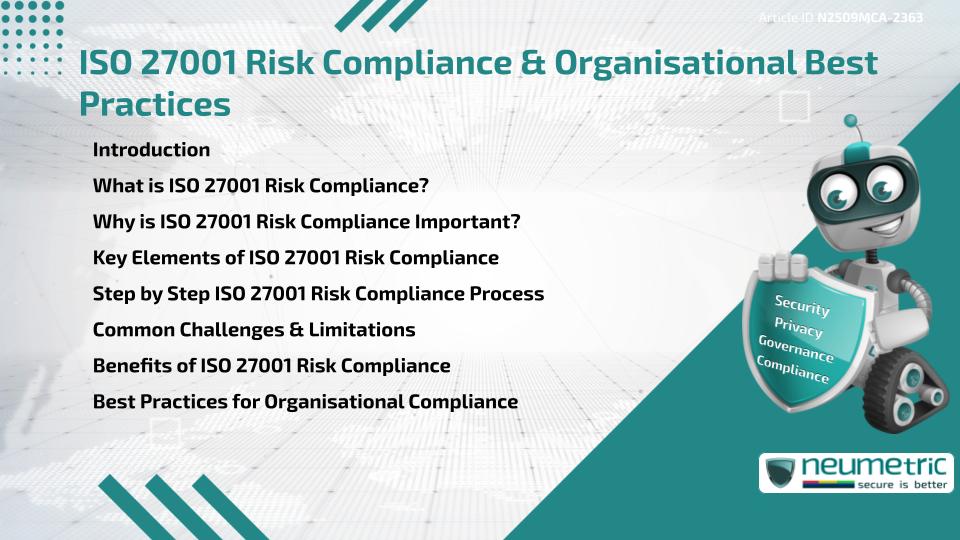Table of Contents
ToggleIntroduction
ISO 27001 Risk Compliance & organisational Best Practices ensure that businesses protect Sensitive Data, manage Risks & maintain alignment with international Information Security standards. This article explains what ISO 27001 Risk Compliance means, why it is important, its core elements & a step by step process to achieve Compliance. It also addresses common challenges, benefits & recommended practices for organisations aiming to strengthen their Information Security management system [ISMS].
What is ISO 27001 Risk Compliance?
ISO 27001 Risk Compliance refers to the implementation of Risk Management processes & Controls in accordance with ISO 27001, the global Standard for ISMS. It involves identifying, analysing & mitigating Information Security Risks while ensuring Compliance with the standard’s requirements. This Compliance demonstrates an organisation’s commitment to safeguarding Confidentiality, Integrity & Availability of information.
Why is ISO 27001 Risk Compliance Important?
The importance of ISO 27001 Risk Compliance lies in its ability to:
- Protect against Data Breaches & Cyber Threats
- Ensure Compliance with Legal, Regulatory & Contractual requirements
- Build trust with Clients, Partners & Stakeholders
- Promote a culture of Risk Awareness across the organisation
- Provide a Framework for Continuous Improvement in Information Security
Key Elements of ISO 27001 Risk Compliance
Core components include:
- Risk Identification – Mapping Critical Assets, Processes & Information flows
- Threat & Vulnerability Assessment – Evaluating potential Risks to assets
- Risk Analysis – Estimating Likelihood & Impact of Security Threats
- Risk Treatment – Applying controls to mitigate identified Risks
- Monitoring & Review – Regularly updating Assessments & Compliance status
Step by Step ISO 27001 Risk Compliance Process
Organisations can achieve Compliance by following these steps:
- Define Scope – Establish the boundaries of the ISMS.
- Identify Assets & Risks – Catalogue Information assets & Potential Threats.
- Assess Likelihood & Impact – Use Risk matrices to prioritise Risks.
- Implement Controls – Apply ISO 27001 Annex A Controls to reduce Risks.
- Document Processes – Maintain Evidence of Risk Assessments & Treatment plans.
- Conduct Internal Audits – Verify Compliance through structured Audits.
- Review & Improve – Monitor progress & continuously refine Controls.
Common Challenges & Limitations
Organisations often encounter:
- Limited resources for Compliance initiatives
- Difficulty in engaging staff at all levels
- Complex Regulatory environments
- Keeping Documentation current
- Balancing Security investments with business priorities
Benefits of ISO 27001 Risk Compliance
Effective Compliance results in:
- Stronger resilience to Cyber Threats
- Improved Customer Confidence & Trust
- Enhanced competitive advantage
- Reduced Legal & Financial Risks
- Greater alignment between Security & Business Objectives
Best Practices for Organisational Compliance
To sustain Compliance:
- Integrate Risk Management into organisational culture
- Provide regular training on ISO 27001 & Security practices
- Use Risk-based Auditing for focused Compliance checks
- Leverage automation tools for Monitoring & Reporting
- Ensure Top Management involvement in Compliance activities
Takeaways
- ISO 27001 Risk Compliance provides a structured Framework for managing Risks
- A step by step process ensures Consistency & Accountability
- Continuous Improvement is essential for long-term Compliance
- Organisational Best Practices strengthen both Compliance & Security posture
FAQ
What is the goal of ISO 27001 Risk Compliance?
The goal is to identify, manage & mitigate security Risks while aligning with ISO 27001 standards.
How often should Risk Assessments be performed for ISO 27001 Compliance?
At least annually & whenever significant changes occur in systems or processes.
Who is responsible for ISO 27001 Risk Compliance in an organisation?
Compliance teams, IT staff & Top Management share responsibility for maintaining Compliance.
What happens if an organisation does not comply with ISO 27001?
It Risks Certification failure, reputational damage, Financial penalties & greater exposure to Cyber Threats.
Does ISO 27001 Risk Compliance apply to Small Businesses?
Yes, any organisation that handles Sensitive Information can benefit from Compliance, regardless of size.
What tools support ISO 27001 Risk Compliance?
Risk Management software, ISMS documentation tools & Auditing platforms are widely used.
How does ISO 27001 Risk Compliance benefit Customers?
It builds trust by ensuring that Customer Data is protected through strong Information Security Controls.
Need help for Security, Privacy, Governance & VAPT?
Neumetric provides organisations the necessary help to achieve their Cybersecurity, Compliance, Governance, Privacy, Certifications & Pentesting needs.
Organisations & Businesses, specifically those which provide SaaS & AI Solutions in the Fintech, BFSI & other regulated sectors, usually need a Cybersecurity Partner for meeting & maintaining the ongoing Security & Privacy needs & requirements of their Enterprise Clients & Privacy conscious Customers.
SOC 2, ISO 27001, ISO 42001, NIST, HIPAA, HECVAT, EU GDPR are some of the Frameworks that are served by Fusion – a SaaS, multimodular, multitenant, centralised, automated, Cybersecurity & Compliance Management system.
Neumetric also provides Expert Services for technical security which covers VAPT for Web Applications, APIs, iOS & Android Mobile Apps, Security Testing for AWS & other Cloud Environments & Cloud Infrastructure & other similar scopes.
Reach out to us by Email or filling out the Contact Form…





